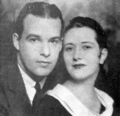Alfred Lunt facts for kids
Quick facts for kids
Alfred Lunt
|
|
|---|---|

Photographed by Carl Van Vechten in 1932
|
|
| Born |
Alfred Davis Lunt Jr.
August 12, 1892 Milwaukee, Wisconsin, U.S.
|
| Died | August 3, 1977 (aged 84) Chicago, Illinois, U.S.
|
| Education | Carroll College, Le Cordon Bleu |
| Occupation | Actor/director |
| Years active | 1903–1966 |
| Spouse(s) | |
Alfred Lunt (born August 12, 1892 – died August 3, 1977) was a famous American actor and director. He worked mostly on stage, especially on Broadway. Alfred Lunt was known for his amazing acting skills. He often performed with his wife, Lynn Fontanne. They were a very famous acting duo. The Lunt-Fontanne Theatre on Broadway is even named after them!
Contents
Alfred Lunt's Acting Career
Alfred Lunt was a very successful actor. He won two Tony Awards, which are top honors for theater. He was also nominated for an Academy Award (Oscar) for Best Actor. This was for his role in the 1931 movie The Guardsman. He also won an Emmy Award for a TV show called The Magnificent Yankee.
Lunt became a big star in 1919. He played a funny character in the play Clarence. But he could play many different kinds of roles. He played a king in Elizabeth the Queen. He also played a powerful businessman in Meteor. People said he was one of the best American actors of his time.
He didn't act in many old classic plays. But he was very good in Shakespeare's The Taming of the Shrew. He also starred in Chekhov's The Seagull. In that play, his wife Lynn Fontanne also acted.
Alfred Lunt's Personal Life
Alfred Lunt was born in Milwaukee, Wisconsin, in 1892. His father died when Alfred was very young. His mother later remarried. They moved to Genesee Depot, Wisconsin. Alfred went to Carroll College in Waukesha, Wisconsin.
Alfred Lunt married Lynn Fontanne on May 26, 1922. They were one of the most famous acting couples in American history. They acted together in more than 20 plays. They were so famous that they even appeared on an American postage stamp after they passed away.
The Lunts made three movies together. They starred in The Guardsman in 1931. They also had small roles as themselves in Stage Door Canteen (1943). In 1958, they stopped acting on stage. They also appeared in radio shows and a few TV shows.
During the summers, and after they retired, they lived at their home called Ten Chimneys. This home is in Genesee Depot, Wisconsin.
Alfred Lunt received special awards for his work. In 1947, he got a medal for speaking well on stage. In 1964, he and Lynn Fontanne received the Presidential Medal of Freedom. This is a very high honor given by the President of the United States.
Alfred Lunt is also part of the American Theatre Hall of Fame.

Alfred Lunt's Death
Alfred Lunt died on August 3, 1977, in Chicago. He was almost 85 years old. He is buried next to his wife in Milwaukee, Wisconsin. After he died, the lights in all Broadway theaters were dimmed. This is a special way to honor a very important person in theater.
Alfred Lunt's Legacy
Alfred Lunt and Lynn Fontanne's home, Ten Chimneys, is now a museum. It helps people learn about theater. The Lunt-Fontanne Theatre in New York City is named after them. This shows how important they were to Broadway.
Selected Broadway Stage Work
- Clarence (1919)
- The Guardsman (1924)
- Elizabeth the Queen (1930)
- Meteor (1930)
- Design for Living (1933)
- The Taming of the Shrew (1935)
- Idiot's Delight (1936)
- Amphitryon 38 (1937)
- The Seagull (1938)
- There Shall Be No Night (1940)
- O Mistress Mine (1946)
- Ondine (1954)
- The Great Sebastians (1956)
Selected Film and TV Appearances
|
|
Radio Appearances
Alfred Lunt and Lynn Fontanne often appeared on the radio show Theater Guild on the Air. These were hour-long plays. They performed together many times.
- The Guardsman, 1945
- Elizabeth the Queen, 1945
- Call it a Day, 1946
- The Great Adventure, 1947
- Pygmalion, 1951
Images for kids
-
Noël Coward, 1925photograph
-
Ten Chimneys, the Lunts' house in Genesee Depot, Wisconsin, now a National Historic Landmark
See also
 In Spanish: Alfred Lunt para niños
In Spanish: Alfred Lunt para niños






